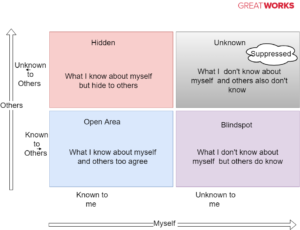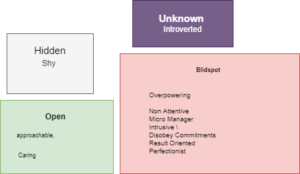
The Johari window to improve my self-awareness is an interesting model to understand human interactions
Last week, I was in an interesting conference,
Mrs.Akila Rajeshwar, Director of TiE Chennai, delivered a session on Culture building. For me, the entire speech looked like she was holding a mirror in front of us. Reflecting on the mistakes which we do in our daily entrepreneurial life. But she made the entire session so interesting we all glued in her speech.
The final verdict from her speech: successful organizations are built on a great culture,
Great leaders, build a great culture
To be a great leader, one should be self-aware
The buck stopped at –Self Awareness
That’s a lot of food for thought in that meeting. on the way back home, several thoughts were running through my mind. The question on my mind is:
How to be self-aware.,
Correctly speaking, it’s not that, I or anyone is not self-aware, there is only a gap in the awareness of what I think about me and what others know about me.
So how to improve self-awareness?
Is there is a solution, is there a tool, is there a mechanism I can become more self-aware,
Yes
The Johari window to improve my self-awareness is a useful tool.
The Johari window is helpful for the leaders who want to understand how their team perceives them. Johari got its name from the first two words of the two American psychologists who invented it, Joseph Luft and Harry Ingham.
So, what’s the Johari window:
For simple understanding, this is a four-quadrant box as in the picture below

In the horizontal lane (X-axis) it’s about yourself, what you know about yourself and what you don’t know about you
In the vertical Y-axis, it’s about what others know about you–and what others do not know about you.
These four boxes are placeholders to be filled with the qualities or the characteristics traits by you and by others. For an easy reference, there are around selective 55 qualities given here.
Let us go deeper to understand these four boxes
1. Open:
This is the place which holds both what you know about yourself and others too, agree that you are this.
No confusion,
This includes your attitude, skills and anything others know about you.
A good example is something like you are a nonstop talker, you love to talk; you are self-aware of this at the same time others also know this and always looking for a way to escape from your discussion.
so your talkative quality has to be put in the open area
2. Blind Spot :
This is where the game starts; this is the characteristics traits you are not aware of or of denial when someone said about you, but the truth is most people believe you have this quality
A good example, I want to share a personal experience. A senior colleague of mine considered himself witty and jovial, but others see him as boring and sarcastic. He was in complete denial when he received feedback from some of the younger colleagues.
Any feedback which is not known to you or you are not able to accept goes into the blind spot
3. Hidden
This is the traits well known to you about yourself but others don’t see this trait of you.
The reason for hidden qualities, still the team communication is not strengthened or there are not enough circumstances to exhibit this quality
If you receive feedback that goes a lot into the hidden areas, means there needs to be a lot of open communication between you and the team. The aim is to move things from hidden to open area.
4. Unknown
Any qualities which are not selected by anyone goes into known
Qualities / Characteristics Traits:
Below is the list of 55 keywords pertaining to leadership qualities. If you think something is to be added, please, let me know in the comments.
1. Approachable
2. Listening
3. Open
4. Caring
5. Overpowering
6. Arrogant
7. Trustworthy
8. Confident
9. Competent
10. Skillful
11. Good communicator
12. Walk the Talk
13. Disobey Commitments
14. Flexible
15. Dependable
16. Supportive
17. Ethical & moral character
18. Boring
19. Disengaged
20. Disrespect to Juniors
21. Non-attentive
22. Cheerful
23. Encouraging
24. Empathy
25. Micro-Manager
26. Intrusive
27. Result Oriented
28. Task Focus
29. Attention to details
30. Reliable
31. Adaptable
32. Bold &Brave
33. Calm
34. Caring
35. Cheerful
36. Energetic
37. Extroverted
38. Introverted
39. Friendly
40. Helpful
41. Idealistic
42. Perfectionist
43. Knowledgeable
44. Kind
45. Loving
46. Mature
47. Interrupt while talking
48. Organized
49. Patience
50. Powerful
51. Shy
52. Silly
53. Trustworthy
54. Warm
55. Witty /Jovial
So How to start this exercise
Step – 1
Start doing a self-analysis. What are your strengths and your weaknesses? Pick the characteristics traits from the above list, don’t go overboard or don’t underestimate yourself, just be yourself, pick the ones which you are convinced. After writing it keep it with yourself, or if you have an accountability partner or a mentor, show it to them.
The game is not over; this is just the 90 degree, the balance to come from others
Step-2
This is where the game starts, Ask your friends, colleagues, your co-workers, or anyone who is known to you at least some length of time,share them the 55 characteristics traits and ask them to give feedback.
Don’t be judgmental about them, whether they will give good feedback. We are not collecting a Google review or a 5 star rating for you
So call someone whom you consider always contradicts with you, do it with a minimum of 7- 10 people, including a variety from your family, friends, colleagues. Tell them this exercise is not to impress you rather, to improve your self-awareness, so ask them to give open and honest feedback.
if you are a digital person use this free tool https://miro.com/app/board after signing in share the link to your participants
To make your life easy, here is a sample request letter. Just forward this to your participants
Hi Friend,
I need your help in improving myself, hope you will spare some time for me
My coach recommended this exercise to improve my self-awareness for the betterment of myself and my organization; your 5 minutes will help in achieving this.
Here is the list of characteristic traits. Choose the ones which describe me the best. Don’t please me or don’t think I get offended by your feedback. If it is negative, give your honest feedback.
Please complete and send it back to me
Expecting your feedback
<your Name >
Done, got the feedback. What’s next?
After collecting the feedback, check how many people coincide with what you think about yourselves. Put that in the Open arena. The larger the open arena, you are a self-aware leader.
If participants share positive or negative traits about you, which are in your unknown area, then it’s time for you to develop awareness around this area. Refer to a realistic picture drawn after the feedback

If there are qualities in your hidden box, then you need to be open up with your team
This exercise is more like a health check test, doing the health check itself doesn’t mean you become healthy.
This is only an eye-opener. The actions for improvements are left to you
If there is some sort of personal advice I could give, then I recommend meditation techniques like Transcendental meditation, which are the permanent solution in the journey of becoming self-aware, but that’s a separate discussion of its own which is outside a business discussion
So could we start the exercise?
Just copy-paste the letter format and the characteristics, send it to your list of participants.
Still hesitating, do you need that accountability partner or a coach? We are just a call away.

Wonderful exercise